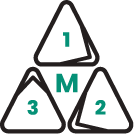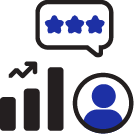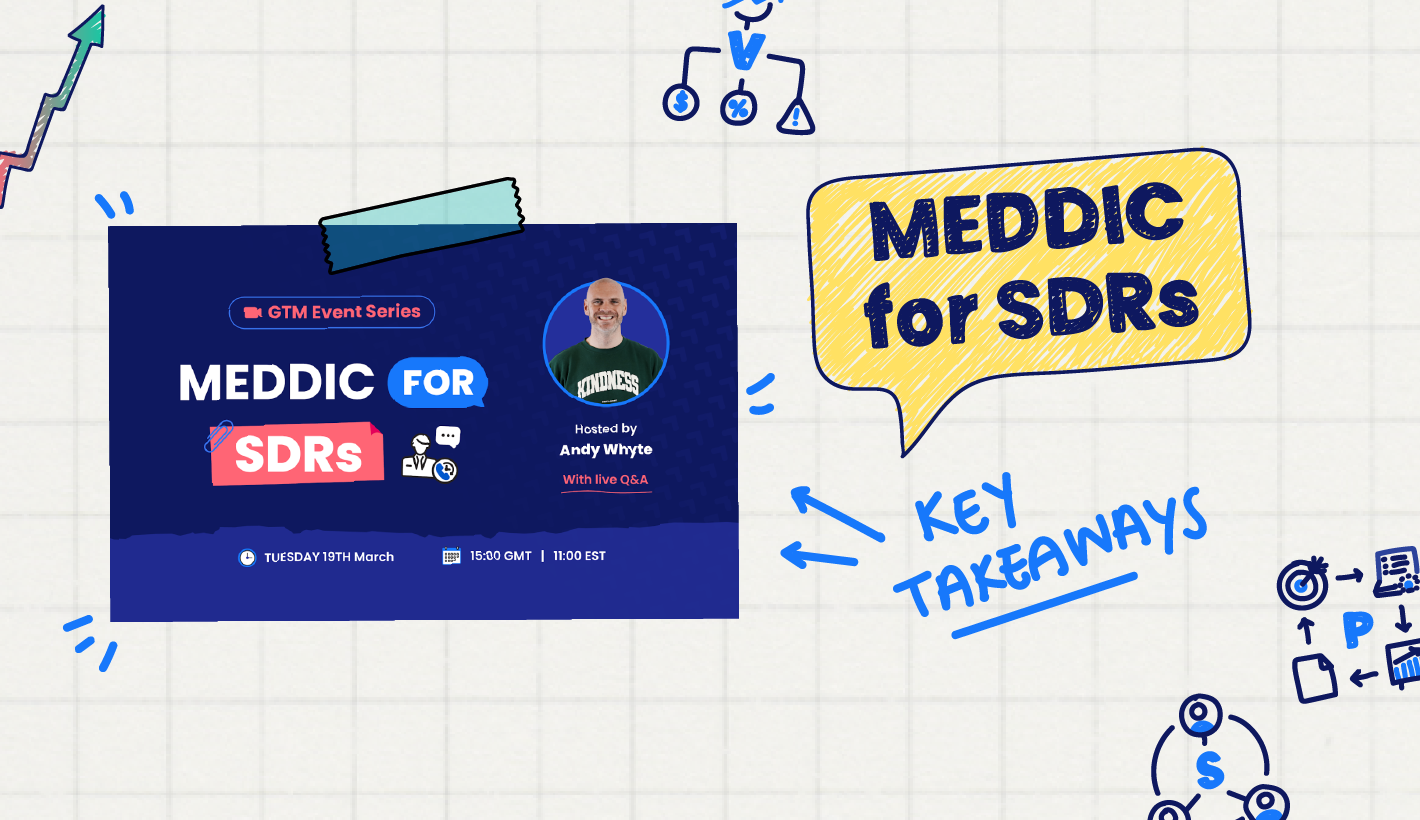Something we love about MEDDIC is how it can be applied across the entire GTM team. That includes SDRs!
SDRs can use MEDDIC to elevate their customer engagements and book more meetings, progressing their career and taking them to the next level.
That’s why we hosted our event: MEDDIC for SDRs, to show SDRs how they can use MEDDPICC in their everyday engagements.
Before we progress to the key takeaways, it’s important to remember: Not all MEDDIC is equal! One great thing about MEDDIC is that it’s an open-source framework that anyone can use and embrace. A downside of that, however, is that there is massive variation in MEDDIC proficiency across our industry.
One goal of this event series is to show people across the GTM team that MEDDIC is not just a qualification framework, but a common language that can skyrocket your selling and a team’s synergy. No matter who you are, the focus of MEDDIC on value, stakeholders, and process will lead you to success.
MEDDIC to book more meetings
It’s tough out there for SDRs. It feels like getting a meeting is almost like playing Red Light, Green Light - one wrong move, and you’re out! Your prospects are busier than ever, and getting their attention has never been more difficult. On top of that, getting through to them is hard - you need to be hyper relevant and credible to capture their attention and to keep it.
To get ahead and book more meetings, SDRs need to be relevant and credible in all their customer engagements, because quality always wins. For SDRs to be relevant and credible at a relative scale, they need MEDDIC.
Implicate the Pain
To be relevant and credible straight out the gate, it helps to have a real, credible example of the pain that comes without your solution or the gain that comes with it. For an SDR, it doesn’t matter how much value your solution brings, if there are no negative implications, there will be no urgency for your customer.
Pain (and gain) can take many forms, be they economic, efficiency, or risk related. When you are implicating the pain with your customer, here are two things you need to remember:
There are different stages: identification, indication, and implication. Identification is just making the customer aware of the pain, and indication is revealing the cost of the pain. Real implication of the pain, looking not only at the cost but the implications of the cost, is how you drive urgency with a customer.
Different people in one organization will feel differently about the same pain, so in outreach, you need to consider the right stakeholder. If you take the wrong pain to the wrong person, you will just be spinning your wheels.
Metrics
To convey the value your solution delivers in a relevant and credible manner, you need to use metrics to communicate the quantified value of your solution. SDRs can use metrics as a shortcut into a value mindset and away from the pitfalls of ‘bells and whistles’.
Keeping relevance and credibility in mind, the metrics you use need to address the interests of the person you’re speaking to. The value you refer to could include increased revenue or efficiency, or decreased risk.
SDRs might find metrics tricky, because without yet speaking to the customer, how do you figure them out? Using what we call M1s, which use proven and relevant value from your existing customer base to enable your prospective customer to rapidly capture an understanding of the value you provide.
M1s help your customer understand what your solution does, what pain you solve, what gain you provide and how you do it. They achieve this while storytelling, reference selling, and avoiding calling the customer’s baby ugly.
Decision Criteria
SDRs might not think Decision Criteria is relevant to them, but as an SDR you have an opportunity to not only differentiate your solution, but to position it as a leader in the customer’s mind. You can make your approach relevant and credible by demonstrating how your solution takes customers from pain to gain.
As sellers, we may forget it, but customers don’t tend to have Decision Criteria. This is a good thing, and presents an opportunity to SDRs to influence the Decision Criteria from the first point of contact.
There are three kinds of Decision Criteria - technical, economic, and relationship.
Stakeholders
As we talked about above, knowing which stakeholders care about what is important in remaining relevant and credible in your outreach. Understanding your stakeholders helps you figure out who cares about this, and also assess the general lay of the land.
At MEDDICC, we say no champion = no deal. Identifying and engaging with a champion, someone with power and influence who is working with you to make progress on the opportunity will increase your chances of success.
To effectively engage with a Champion, it is important to align with their vested interests. To figure out how to do that, you can use the Value Pyramid. We have devoted an entire program to the Value Pyramid, but the main takeaway is that you can view a customer’s overall goals and determine what the initiatives, strategies, obstacles and needs are, and how you can help. As an SDR you have a lot of avenues you can pursue and this may sound like more work than it’s worth, but to unlock big accounts, taking time to research is worth it.
A similar approach can be taken with the Economic Buyer. When it comes to engaging the EB, the worst case scenario is they delegate you down to a Champion.
A stakeholder you can’t ignore is the Competition. However, as an SDR you should be very selective with how you talk about the competition. Do it only when there is a crystal-clear pain relating to the competition that you can solve uniquely, or when you are acting on intel that suggests you should.
M1s: the SDR’s Savior
M1s are the capsulation of the value of your solution based on customer success stories. They contain the PAIN without your solution and the GAIN with it, the METRICS used to measure the delta, the DECISION CRITERIA required to replicate it, and the STAKEHOLDERS involved.
M1s thrive with relevance and lend you credibility. They rely on industry, size, use-case and location.
Components of a Proposition
You can use the elements of MEDDIC to compose your customer outreach. Think of it under these three headings:
Without you: what is the pain without your solution? What are the costs of that pain? What are the negative implications?
With you: what is the gain with your solution? What is the value of that gain? What are the positive implications? How do you get there?
Who cares?: Who is the ideal contact? Who is the overall authority? Who is our competition?
When creating your proposition, it’s important to maintain your own style - it’s how you differentiate yourself. By tying in MEDDIC in your outreach, you allow for a seamless handover to the AE when it comes to the meeting itself. You provide a clear briefing on what caught the customer’s attention, so they can double down, and the customer is happy because the value being communicated to them feels relevant to them.
MEDDIC to get promoted
MEDDIC is like the Harvard of sales - it teaches you to be the best. Some people will disavow MEDDIC, but those people have never used it and often have an ulterior motive. The fact is that the best of the best use MEDDIC - of the top eight public cloud companies, seven use MEDDIC.
So, if you’re an SDR using MEDDIC, you’re on the right track. But how do you best progress in your career? Sometimes SDRs will go to a new company for a promotion, but if they get the company wrong, they might not actually progress at the rate they want; an SDR role at a good company may be better than an AE role at a bad one.
It’s important to pick the right road to go on - you might feel like you’re moving up, but you could be in the slow lane. But what are the Decision Criteria for the right company?
People. Trust your gut about the people you meet in the hiring process - could you see yourself working for them? When researching the company, look for success. Are people being promoted? What are the people who work for them like? Good people follow good people, so you can learn a lot from the kinds of people across the organization.
Growth. It doesn’t need to be insane growth, but how do they perform in comparison to other companies in their sector? Is their solution changing the game?
Execution. Does it look like a place where you can learn from them? Do they use MEDDIC? Is it a little bit scary? The best opportunities are the ones where you feel a little intimidated, because it means you will have the chance to grow.
When looking for a promotion or for a new role to progress in your career, you can treat it like sales - except you’re selling yourself (not like that!). And like sales, you can apply MEDDIC.
Showcase your value
Implicate the pain: Why are they hiring? What are the implications if they get this hire wrong?
Metrics: What are the metrics of their most successful sellers?
Decision Criteria: What are the attributes that lead their team to success?
Engage stakeholders
Champion: who cares about this role? What do they need to see from you to be your Champion?
Economic Buyer: Who is the person of the highest authority involved in this hiring decision? What are they looking for?
Manage a process
Decision Process: Determine what good looks like, and how you can showcase your skills early.
When you understand what they are looking for and how they measure success, you can tie in your own value - what do they stand to gain from hiring you? By identifying the key stakeholders, you know who you need to win over. In managing the process, you can be sure to win at every hiring stage.
Equipped with MEDDIC, SDRs can accelerate their sales acumen and truly shine in their roles. Have a look at our guide on how SDRs can use MEDDPICC.





.png)





.png)
























%201.png)










.png)
.png)
.png)